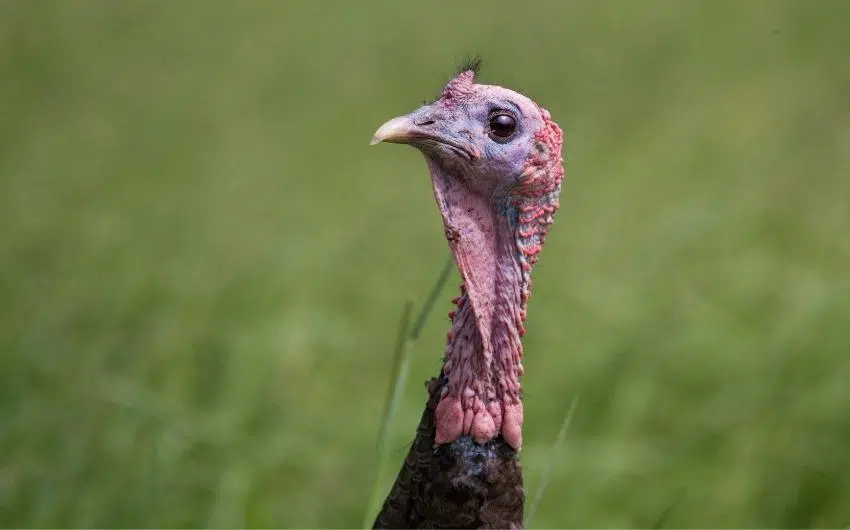After a solid first week of the spring turkey season, I went into the weekend with a forecast of unseasonably cold temperatures and a higher-than-average wind speed.
On the sixth morning in a row of waking up at 4 a.m., it would have been easy to pull the covers over my head, go back to sleep and head out for a midday hunt. Not only was I tired, I knew the weather conditions were going to be less than ideal. My enthusiasm for the morning was lower than usual, and I was trying to find excuses for why I should not go hunting.
That morning two things pulled me out of bed: the plans I had made to hunt with a good friend and the fact that I had two unfilled turkey tags in my pocket. With the wind blowing and the temperatures in the low 30s, we made our way down a wooded fence row that typically was in an area that turkeys roosted. As we made it into the region where we had planned to hunt, we had yet to hear our first gobble. After using an owl call, we continued to have no luck of a gobbler answering us.
We elected to sit down on the fence row with no located turkeys found and make a few calls in hopes of a gobbler getting fired up. After ten minutes of silence, except for the howling of the high winds, I was shocked to pick out two gobblers who were roosted in the same tree approximately 100 yards through the timber. The two gobblers had never made a sound all morning, so I was surprised when my eyes adjusted to the low light to see them roosted.
After calling periodically with no response, it was now 7:40 a.m., and the two toms were still on the roost after a solid hour of daylight. Finally, the first gobbler leaned forward and pitched off onto the ground, followed by the second tom. With my diaphragm call still in the side of my mouth, I made two soft yelps. The two toms walked directly towards my buddy and me as if they were on a string. They were a mere 20 yards when they reached the fence row where we were sitting. The only problem was that I was the only one who could shoot from where they entered the fence row. After shooting the first tom, the other ran down the fence and then out of sight. The entire occurrence left my friend and me wondering why they had never made a sound and what had just happened.
You must go hunting if you want to harvest a turkey. Hunting turkeys in bad weather can have several different meanings. Windy and cold days like my friend and I experienced can be considered bad weather. Often the spring season can have multiple days of rain forecasted. Hunting in the Midwest, mainly in Missouri, you never really know what the weather will entail; I have even hunted turkeys in the snow during April. No matter what the weather conditions may be, I know the spring season only lasts a few weeks of the year, then you are left waiting for another 365 days to do it all over again. Whatever the forecast may be, one thing is required to harvest a bad weather gobbler: patience.
Spring turkey season brings unpredictable weather, with rain and storms often arriving right when hunting heats up. While most turkey hunters prefer sunny days, don’t let wet weather keep you inside. With the right tactics, you can absolutely hunt turkeys successfully in the rain.
Do Turkeys Move in the Rain?
Turkeys don’t stop their normal activities just because it’s raining. However, rain does impact their behaviors in some key ways:
- Delayed fly down from roost in heavy rain
- Less gobbling when downpour is occurring
- Seek shelter under tree canopy or move to open fields
- Rely more on eyesight than hearing for danger
- Will still respond to calls, but reduced hearing range
So while the hunting may be tougher, turkeys are still out there. Learning to hunt them effectively in wet conditions is vital for tagging birds in spring.
6 Tips for Turkey Hunting in the Rain
Follow these tips to fill your tag even when the weather is far from ideal:
1.Sleep In Slightly
If awakened by heavy rain, wait it out rather than go out pre-dawn Gobblers often delay fly down in downpours Use the extra sleep.
2. Time Your Hunt
Monitor the forecast and radar apps. Plan to be in the woods as storms clear for prime gobbling.
3. Seek Openings
Target open fields logging roads and power line cuts. Turkeys move into open areas where they can see danger in rain.
4. Use Blinds
Pop-up blinds allow calling while staying dry. Set up near expected travel routes. Bring a seat to stay comfortable.
5. Go Visual
With less gobbling, rely on spotting turkeys moving into openings. Avoid spooking them while sneaking into position.
6. Get Loud
Calls like box calls carry well in rain. Call aggressively to overcome decreased hearing distance of wet turkeys.
Gear Up for Wet Weather
Having quality rain gear makes hunting turkeys in storms much more bearable:
- Lightweight, breathable rain jacket and pants
- Waterproof boots with aggressive tread
- Shooting gloves to keep hands dry and warm
- Facemask to keep calling mouth diaphragms dry
The right specialized gear allows you to power through inclement weather and remain focused on the hunt.
Be Patient and Stay Positive
Hunting turkeys in the rain tests your grit. But your dedication can really pay off. Some tips:
-
Persistence brings opportunity. Don’t throw in the towel.
-
Remember – no other hunters out there!
-
Unexpected gobbling as weather clears is magical.
-
Killing a tom in tough conditions is deeply satisfying.
-
Getting soaked is worth it when you’re holding a heavy gobbler.
April showers bring May flowers, and with the right mindset and tactics, they also bring spring longbeards! Don’t retreat to the couch—get out there and start filling tags rain or shine. With turkeys still active in wet weather, you can absolutely hunt and succeed during storms.

Cold And Windy Days
When the temperatures are cold and windy, a spring gobbler is no different from humans; they are a little slower getting out of bed. I think a turkey knows that it is a battle to fight the wind and stay warm after they fly down. It is common for gobblers to stay on the roost for an extended period, as with my hunt. Even when it is their breeding season, they lose their ambition and stay on the roost where they have been relaxing all night. S
taying on the topic of the breeding season, hens are another reason for a slow start when the weather is cold and windy. When temperatures are colder, hens often stay on their nest to keep their eggs warmer, and it is probably warmer for them to stay there as well. Fewer hens out wandering around means less activity for the gobblers to encounter, thus being the reason behind breeding activities being slower when the weather is terrible.
The key to lousy weather hunting is not to let it deter you. Instead, use it to your advantage. It may take more time, yet gobblers will respond to calling. When hens are on the nest, gobblers get lonely. When hunting in colder, damp weather, it is vital to dress the part. You must face the elements and stay in the woods to harvest turkeys. Wear a warmer garment such as the new Blocker Outdoors Silentec jacket and pants in Bottomland. Garments such as Silentec keep you warm and comfortable when waiting out a slow-moving gobbler. Plus, the soft outer layer keeps you quiet when turkeys are in close range, which is a must when spring turkey hunting. Outlasting mother natures elements means you will be ready whenever a gobbler decides he is ready to play.
Turkey Hunting in the Rain
FAQ
Is it worth turkey hunting in the rain?
No matter where you target turkeys, early season hunts often find you in the rain. At this time the testosterone levels are high in toms, and they’re ready to breed. This means they’ll react to calls and decoys, even in the rain.
How active are turkeys in the rain?
During and after a rain, gobblers will crowd into flooded fields to eat swampy insects and other grubs from the ground. Turkeys like to huddle in open fields during rainfall because their eyesight is not as good in those conditions, and the rain falling on leaves through trees limits their hearing.
Can turkeys be left out in the rain?
Ensure turkeys have adequate shelter to protect them from heavy rain and cold temperatures, as they can succumb to hypothermia if they get too wet and cannot warm up.
Is it OK to hunt in the rain?
Advantages of Hunting in the Rain
The wet understory can dampen the sound of footsteps, allowing you to get closer to your quarry. Spending the day sitting in your stand on a hot feed-tree or on a nice travel route can be equally effective, especially during the rut.
